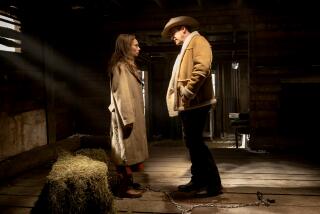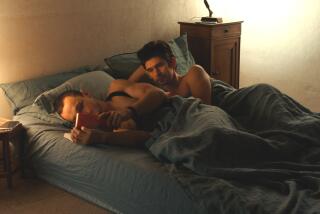TV Focuses on the Other Set of Ratings
- Share via
ALEXANDRIA, Va. — Meet Crissy Brookhart, the woman who rates the ratings. She calls herself a “television analyst.” The entertainment industry calls her a “Hollywood basher.”
Just 25 years old, Brookhart monitors sex, violence and foul language on TV for the unabashedly conservative Media Research Center, a watchdog group based in this Virginia suburb. It is a job that has taken on new proportions with the advent on Jan. 1 of television’s first-ever ratings code.
Last month, Brookhart hit pay dirt: the ABC sitcom “Life’s Work.” The network had labeled the show TV-PG (parental guidance suggested). That means some parents would find the show “unsuitable for younger children.” But it should be fit for 10-year-olds.
“Life’s Work” is a family comedy, featuring a working mom / prosecutor named Lisa. In one episode, the gags center on a man who is arrested for masturbating against a tree. “You haven’t lived,” Lisa jokes, “until you’ve gotten yourself some oak.”
This was not, in Brookhart’s estimation, fare that most parents would serve their 10-year-olds.
As a result, the Jan. 7 installment of “Life’s Work”--30 minutes of art or trash, depending on one’s viewpoint--has become a symbol of a debate over just how much good television’s new ratings are doing for America’s children, and whether any ratings system can ever garner the approval of a fragmented public.
More than anything, it is a debate about values. In a society where many parents are desperately trying to protect their children from images of sex and violence on television (even pop star Madonna, having entered the ranks of motherhood, recently complained that “TV is poison”), the new ratings system was supposed to quell mounting criticism of the industry.
It has done just the opposite, by pitting the networks against an array of Crissy Brookharts--armchair critics with diverse political and social perspectives.
In a nation that has more than twice as many television sets as households, everybody has an opinion of what’s good and bad on TV. And now that there is a ratings code--a system that, in effect, gives Americans their first insight into just who the television industry thinks ought to be watching its programs--it seems that everybody has an opinion of what’s good and bad about the ratings.
Why, some critics would like to know, does CBS tag “Late Show With David Letterman” TV-PG, while NBC gives “The Tonight Show With Jay Leno” the more cautionary rating of TV-14 (unsuitable for children under 14)? If the “F-word” is drowned out by the sound of a drill, as occurred on another recent episode of “Life’s Work,” does that merit a PG rating? Why not TV-14?
Why was the movie “Schindler’s List,” which aired Sunday, the first and thus far the only network program to receive the rating of TV-M (for mature audiences)? Does that mean everything else on network television--from “NYPD Blue” to “The X-Files”--is fit for teenagers?
And what to make of the complaints of U.S. Rep. Tom Coburn (R-Okla.), who says that the very airing of “Schindler’s List”--”with full frontal nudity, violence and profanity”--demonstrates that the ratings code will only encourage more TV sex and violence, rather than diminish it?
These questions will take center stage in Washington today as the Senate Commerce Committee conducts the first public hearing on the effectiveness of the new code. At issue is whether the nation’s TV moguls have lived up to the promise they made one year ago, when they convened at the White House to announce that they would devise a ratings system that would be “useful and valuable to the parents of America.”
Jack Valenti, the head of the Motion Picture Assn. of America and the chief architect of the ratings, believes they have. He points to a recent poll conducted by the Pew Research Center in Washington, which found that 27% of all respondents said the ratings were very helpful, and that an additional 42% said they were somewhat helpful.
But he makes no apologies for how shows are being rated. Nor does ABC, whose spokeswoman vehemently defends the PG rating given to “Life’s Work” (which has completed its first-season run and is now off the air).
“Keep in mind,” Valenti says, “that prime-time television is mostly PG. There’s not a single show on prime-time television that, if it were presented to the movie ratings system, would get more than a PG-13. . . . Tell me the show that you believe ought to be rated M, which is not for children under 17. Pick out a show, pick out any of them. The point is, there are none.”
*
There are none if you are Jack Valenti. But if you are Crissy Brookhart and her colleagues at the conservative Media Research Center, there are plenty. And that, Valenti says, is the difficulty of any ratings system: “You’re dealing with subjectivity. What is correct is in the eye of the beholder.”
In Colorado Springs, Colo., the editor of Plugged In, a newsletter put out by the conservative group Focus on the Family, finds the ratings so useless that he doesn’t include them in his column evaluating TV’s hottest shows. Having the networks rate their own programs, Robert Smithhouser says, “is like the fox in the henhouse.”
In Minneapolis, psychologist David Walsh--father to three teenagers--has devised his own alternative code, employing panels of parents to rate shows using a system based on traffic signals. CBS’ “The Nanny” gets a red light for sexual innuendo but a green light for violence. Fox’s “Mighty Morphin Power Rangers” gets a red light for violence but a green light for sex. So far, about 50 shows have been rated; parents can find them on Walsh’s home page: https://mediaandthefamily.org/.
Former FCC Chairman Newton Minow believes the solution will be found in independent ratings systems that will eventually spring up. The American Civil Liberties Union can have one code, the Christian Coalition another. Parents can pick the code they like.
But that technology is not yet here. For now, the only ratings America has are those offered by the industry itself. So organizations from the National Parent Teachers Assn. to the advocacy group Children NOW are pressing for the 2-month-old code to be revised to include more specific information about a program’s content.
Complains U.S. Rep. Ed Markey (D-Mass.), one of the industry’s harshest critics: “TV-PG means Too Vague, Parents Give Up.”
Markey and others have suggested the ratings code include designations such as V, S and L--for violence, sex and language, each on a sliding scale of 1 to 5. In this scenario, which has been tested in Canada, “Life’s Work” might have been rated something like V1, S3, L2--a system that industry executives say is far too confusing for consumers.
“Too cumbersome,” Valenti says. “Calculus is easier.”
*
To understand why there is so much controversy over the ratings--and why the television industry will fiercely resist any changes--it is worthwhile to examine how they came about.
Any story of the ratings system must begin with Markey, the congressman from Massachusetts. In 1975, when Markey was a state representative, a homeless man in Boston was doused with gasoline and burned to death by a street gang. The incident mirrored a grisly scene in a television movie that had aired earlier that week.
A debate ensued: Whose fault was the murder? Was it the fault of parents, who let their kids watch violent television? Or was it the fault of the broadcasters? Markey took the latter view and launched what would become a 20-year crusade against violence on television.
In 1989, a Canadian engineering professor named Tim Collings had a similar experience. A man walked into an engineering school in Montreal and shot 14 students to death before turning the gun on himself. Police found violent videos in the man’s apartment, prompting much of Canada--including Collings--to question the role of the media in violent behavior.
“It seemed to me that there was no way you would ever convince the industry to tone things down,” Collings says. “So I said, ‘Well, then surely we can develop something. . . .’ ”
Thus was born a little electronic device Collings called the Vyou Control--a pun (Canadian humor) on the word “view”--that could be implanted in television sets, allowing parents to block violent shows if programs were encoded with a rating. When Markey got wind of the invention, he gave it a catchier moniker: the V-chip.
The V-chip was catapulted into the American consciousness last year when Congress passed a new telecommunications bill requiring all new television sets to have one beginning sometime in 1998. At the same time, the lawmakers said that if the television industry did not adopt a ratings code voluntarily, the government would establish one.
This was not, in Hollywood, a popular move. “The immediate reaction was, ‘Call the lawyers,’ ” says Tony Podesta, an industry public relations man. Many in the industry thought the government’s ratings push could be challenged as a violation of broadcasters’ First Amendment rights. But Valenti had other ideas.
By Feb. 29, 1996, the day President Clinton had invited television executives to the White House for a summit--Valenti had poked, prodded and cajoled the rest of the industry into agreeing to establish a voluntary ratings system, as he had done 30 years ago with the movie industry. To Podesta, it was “a miracle. These are people who don’t agree on anything, who fight all the time, who don’t like each other.”
*
It was after the summit, Valenti says, that the real work began: designing a ratings system that the less-than-eager executives would sign off on.
Children’s advocates wanted a code that would give parents detailed information about a show’s content. The industry, however, settled on a simpler system, modeled on the one the movies use.
But the Media Research Center, in evaluating 150 hours of prime-time programming during the first weeks of the ratings, found that 61% of all shows were rated PG. How many parents would be willing to use a V-chip to block PG shows from their sets?
“The only way I can block out violence is to block out everything,” says Dale Kunkel, a UC Santa Barbara professor who studies the link between television and violence. “That’s the same thing as the off switch.”
*
While the debate rages, Crissy Brookhart carries on. At the Media Research Center, it is her job to monitor ABC; other analysts handle NBC, CBS and Fox. Each night, she tapes the prime-time shows on her network for viewing the following morning. As she watches, she types notes into a computer, helping to build the organization’s massive database, in which more than 10,000 hours of programming are analyzed from the perspective of a conservative.
Wednesdays are her toughest day--that’s when she views the Tuesday night shows, including “Roseanne” and “NYPD Blue.” Mondays are fairly smooth--that’s when she looks at the Friday night lineup: “Family Matters,” “Boy Meets World,” “Sabrina, the Teenage Witch” and “Clueless.” “It’s two hours of shows, and it takes two hours to watch,” she says. “They never swear.”
She pauses to reconsider. “Well, sometimes they say, ‘Bite me.’ ”
More to Read
The complete guide to home viewing
Get Screen Gab for everything about the TV shows and streaming movies everyone’s talking about.
You may occasionally receive promotional content from the Los Angeles Times.






